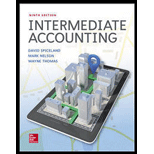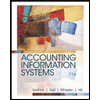
1.
Gross Profit Method: Under this method, the beginning inventory is added to the net purchases during the period which results in the goods available for sale. Then, the estimated cost of goods sold is deducted from the goods available for sale to estimate the ending inventory.
Inventory turnover ratio: This is a financial metric that is used to quantify the number of times the inventory is used or sold during an accounting period.
To state: the inventory method that T Corporation uses to value its inventories.
2.
To state: the additional expenditures that the company includes in the initial cost of merchandise.
3.
To Calculate: the gross profit ratio and the inventory turnover ratio for the fiscal year ended January 30, 2016, and also compare the ratios.
Want to see the full answer?
Check out a sample textbook solution
Chapter 8 Solutions
INTERMEDIATE ACCOUNTING (LL) W/CONNECT
- Q:10 , 11 Plzz answer botharrow_forwardQuestion 4 of 8 Current Attempt in Progress Marigold Company uses the LCM method, on an individual-item basis, in pricing its inventory items because it uses LIFO to value its inventory. The inventory at December 31, 2025, consists of products D, E, F, G, H, and I. Relevant per-unit data for these products appear below. Estimated selling price Cost Replacement cost Estimated selling expense Normal profit Item D Item E Item F Item C $ $ Item D $ $252 158 252 63 42 Item E $231 168 151 63 42 Item F $200 168 147 63 42 Item G $189 168 63 53 42 Item H $231 105 Using the LCM rule, determine the proper unit value for balance sheet reporting purposes at December 31, 2025, for each of the inventory items above. 147 63 42 Item I $189 76 63 63 42arrow_forward11arrow_forward
- С23 Jx А B C. D E F G H. K I also need your assistance in claulating the following economic order quantity (Qe) given new data for 2017. Our inventory generally follows Pareto's Law; therefore, I have emphasized controlling those items representing the majority of our inventory activity. One of those items in IV (intravenous) setups. Our current situation is as follows: 2016 Price $50 for each IV setup 50,000 $25 2017 Demand 2017 Operating Cost 2017 Interest 6.25% 2017 Holding Cost $0.50 The IV distributor would like to distribute a new model setup in 2017 at the same price, but he tells us that he is willing to reduce our carrying costs by making monthly deliveries. After discussing this proposal with Ms. Care, I discovered that training will be required for the new setup. Ms. Care believes, and the distributor agrees, that each registered nurse (RN) will be required to attend a 2 hour seminar. I'm not sure where we put this training cost in the total cost formula. Ms. Care tells me…arrow_forwardChapter 8 Perform (ASAC LO 5 and BSAC LO 2) Kingbird Company began operations late in 2024 and adopted the conventional retail inventory method. Because there was no beginning inventory for 2024 and no markdowns during 2024, the ending inventory for 2024 was $13,708 under both the conventional retail method and the LIFO retail method. At the end of 2025, management wants to compare the results of applying the conventional and LIFO retail methods. There was no change in the price level during 2025. The following data are available for computations. Cost Inventory, January 1, 2025 Sales revenue Net markups mu Net markdowns mo Purchases Freight-in Estimated theft (b) The LIFO retail method. Ending inventory at cost Ending inventory at retail Cost $ $13,708 $ 63,900 5,888 Retail Compute the cost of the 2025 ending inventory under both: (a) The conventional retail method. $20,200 77,000 mu 9,900 mD 1,800 ex Beg Ending inventory using the conventional retail method $ 87,500 2,200 27336 40800…arrow_forwardQ16arrow_forward
- 8–6 Various inventory costing methods; gross profit ratio ● LO8–1, LO8–4, LO8–7 Topanga Group began operations early in 2024. Inventory purchase information for the quarter ended March 31, 2024, for Topanga’s only product is provided below. The unit costs include the cost of freight. The company uses a periodic inventory system to report inventory and cost of goods sold. Date of Purchase Units Unit Cost Total Cost Jan. 7 5,000 $4.00 $20,000 Feb. 16 12,000 4.50 54,000 March 22 17,000 5.00 85,000 Total purchases 34,000 $159,000 Sales for the quarter, all at $7.00 per unit, totaled 20,000 units leaving 14,000 units on hand at the end of the quarter. Required: Calculate Topanga’s gross profit ratio for the first quarter using: FIFO LIFO Average cost Comment on the relative effect of each of the three inventory methods on the gross profit ratio.arrow_forwardPROBLEM 15 Examination of the records of Hopper Company for the year ended December 31, 2021 revealed the following: • Inventory at January 1, 2021 was overstated by P71,000. • Inventory at December 31, 2021 was understated by P96,000. • During 2021, Hopper received a P60,000 cash advance from a customer for merchandise to be manufactured and shipped during 2022. The P60,000 was credited to sales revenue. • Profit (before adjustments) reported on the 2021 profit or loss was P658,000. Explain the right profit for 2021arrow_forwardE 8-5 Inventory transactions; missing data • LO8-1 A company has the following information in its records. Certain data have been intentionally omitted ($ in thousands). Beginning inventory Cost of goods sold 2024 2025 2026 $ 7 $ ? $225 Ending inventory སྐྱི་ 627 621 ? 225 216 Cost of goods available for 876 ? 800 sale Purchases (gross) 630 ? 585 Purchase discounts 18 15 ? Purchase returns 24 30 14 Freight-in 13 32 16 Required: Determine the missing numbers. Show computations where appropriate.arrow_forward
- D1arrow_forwardh2arrow_forward37 [Question text] The length of time between the purchase of inventory and the receipt of cash from the sale of that inventory is called_________________________. Select one: A. accounts payable period B. inventory period C. operating cycle D. accounts receivable periodarrow_forward
 Corporate Financial AccountingAccountingISBN:9781305653535Author:Carl Warren, James M. Reeve, Jonathan DuchacPublisher:Cengage Learning
Corporate Financial AccountingAccountingISBN:9781305653535Author:Carl Warren, James M. Reeve, Jonathan DuchacPublisher:Cengage Learning Accounting (Text Only)AccountingISBN:9781285743615Author:Carl Warren, James M. Reeve, Jonathan DuchacPublisher:Cengage Learning
Accounting (Text Only)AccountingISBN:9781285743615Author:Carl Warren, James M. Reeve, Jonathan DuchacPublisher:Cengage Learning Financial AccountingAccountingISBN:9781337272124Author:Carl Warren, James M. Reeve, Jonathan DuchacPublisher:Cengage Learning
Financial AccountingAccountingISBN:9781337272124Author:Carl Warren, James M. Reeve, Jonathan DuchacPublisher:Cengage Learning Intermediate Accounting: Reporting And AnalysisAccountingISBN:9781337788281Author:James M. Wahlen, Jefferson P. Jones, Donald PagachPublisher:Cengage LearningBusiness/Professional Ethics Directors/Executives...AccountingISBN:9781337485913Author:BROOKSPublisher:Cengage
Intermediate Accounting: Reporting And AnalysisAccountingISBN:9781337788281Author:James M. Wahlen, Jefferson P. Jones, Donald PagachPublisher:Cengage LearningBusiness/Professional Ethics Directors/Executives...AccountingISBN:9781337485913Author:BROOKSPublisher:Cengage Accounting Information SystemsFinanceISBN:9781337552127Author:Ulric J. Gelinas, Richard B. Dull, Patrick Wheeler, Mary Callahan HillPublisher:Cengage Learning
Accounting Information SystemsFinanceISBN:9781337552127Author:Ulric J. Gelinas, Richard B. Dull, Patrick Wheeler, Mary Callahan HillPublisher:Cengage Learning





